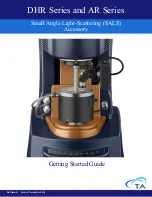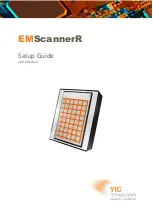
P3031 & P3032
Users Manual
3-2
Note
At low pressures, the piston may require lifting manually to overcome the
‘stick’ due to surface tension of the film of fluid that will develop between
the top of the cylinder and the underside of the weight carrier.
6.
Gently rotate the weight stack clockwise, such that it is turning between
approximately 10 and 60 rpm. Avoid side-loads when turning the weights by placing
the palms of the hands on either side and “rolling” the stack by pulling in opposite
directions, see Figure 3-2.
DO NOT rotate weights when the piston is against the
top or bottom limits of travel.
7.
Allow a few moments for the system to stabilize before taking any readings,
especially after large changes in system pressure.
8.
For the next higher calibration point, repeat from step 3 above.
9.
To measure reducing pressures, remove the necessary weights, and by opening and
closing the Exhaust valve, SLOWLY reduce the system pressure until the piston
floats, then rotate clockwise as above.
10.
Depressurize the system by SLOWLY opening the Exhaust valve, as sudden
depressurization will cause the weight stack to fall quickly, which may damage the
piston assembly.
11.
Remove the weights from the piston.
12.
The fluid level should be checked and maintained as required, periodically
(dependant upon use).
Always ensure that the system is fully depressurized before
removing the filler plug.
Remove the filler plug and introduce more fluid with the
filler bottle, until it reaches the bottom of the filler port, then replace plug.
gmg10.bmp
Figure 3-2. Weight Rotation
Summary of Contents for P3031
Page 6: ...P3031 P3032 Users Manual iv...
Page 8: ...P3031 P3032 Users Manual vi...
Page 18: ...P3031 P3032 Users Manual 2 6...
Page 22: ...P3031 P3032 Users Manual 4 2...
Page 30: ...P3031 P3032 Users Manual 5 8...
Page 32: ...P3031 P3032 Users Manual 6 2...
Page 34: ...P3031 P3032 Users Manual 7 2...
















































